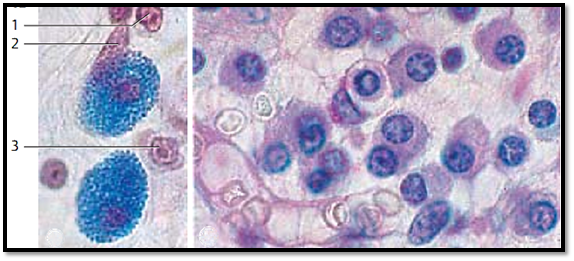
Free Connective Tissue Cells-Mast Cells and Plasma Cells
 المؤلف:
Kuehnel, W
المؤلف:
Kuehnel, W
 المصدر:
Color Atlas of Cytology, Histology, and Microscopic Anatomy
المصدر:
Color Atlas of Cytology, Histology, and Microscopic Anatomy
 الجزء والصفحة:
الجزء والصفحة:
 11-1-2017
11-1-2017
 1754
1754
Free Connective Tissue Cells-Mast Cells and Plasma Cells
Figure a shows two oval, basophilic granulate d mast cells from connective tissue of the greater omentum. As single cells, but more frequently in small groups, mast cells occur particularly of ten in the vicinity of small vessels. Mast cells (diameter 6–12 μm) contain a rounded nucleus. Their cytoplasm is loaded with basophilic, metachromatic granules. Paul Ehrlich (1877) interpreted these as alimentary storage granules (Ehrlich’s mast cells). Mast cells synthesize, store and extrude the acid and sulfatized glycosaminoglycan heparin, the biogenic amines serotonin (only rat and mouse) and histamine, also two additional factors, which play a role in anaphylactic reactions. Histamine is release d in large amounts during allergic reactions. It causes a widening of the capillaries. Figure b depicts plasma cells in the lamina propria from pyloric mucous membranes. Like mast cells, they are free cells and occur in loosely organized or in reticular connective tissue, usually in small groups. Plasma cells (diameters 10–20 μm) are round or polygonal, with a large cytoplasmic compartment—hence the name plasma cell. Their cytoplasm is basophilic and without granules. In electron micrographs, plasma cells are rich in ergastoplasm and free ribosomes. This explains the basophilia of plasma cells. They participate in the synthesis of serum proteins, particularly in the synthesis of gamma globulins. One of their characteristics is the round, usually eccentric nucleus and its nuclear membrane. Chromatin bodies are attached to the nu-clear membrane in a regular pattern. Often, there is a radial chromatin organization pattern ( wheel-spoke nucleus). Plasma cells represent the final stage in the series of B-lymphocytes. They arise from B-lymphocytes after contact with an antigen. The B-lymphocytes migrate from blood to the connective tissue.
1 Lymphocyte
2 Fibrocyte
3 Histiocyte
a) Stain: toluidine blue-paracarmine; magnification: × 510
b) Periodic acid-Schiff (PAS) leucofuchsin stain-hematoxylin; magnification: × 410

References
Kuehnel, W.(2003). Color Atlas of Cytology, Histology, and Microscopic Anatomy. 4th edition . Institute of Anatomy Universitätzu Luebeck Luebeck, Germany . Thieme Stuttgart · New York .
 الاكثر قراءة في علم الخلية
الاكثر قراءة في علم الخلية
 اخر الاخبار
اخر الاخبار
اخبار العتبة العباسية المقدسة


